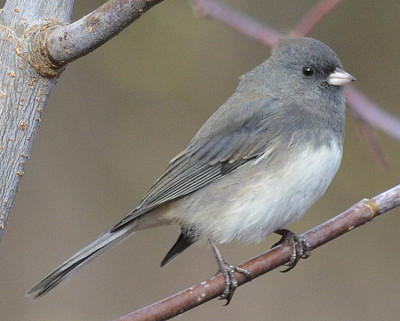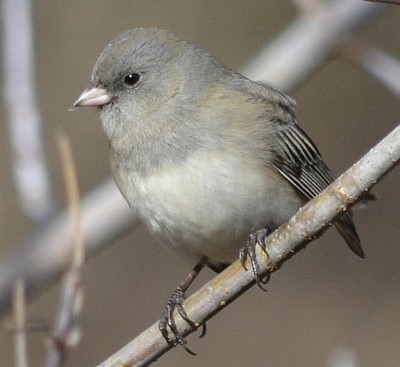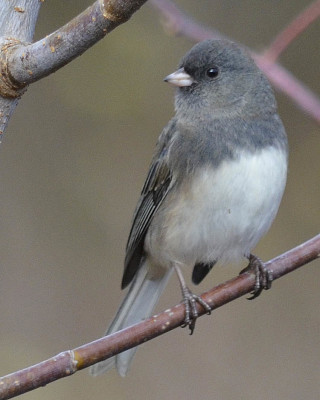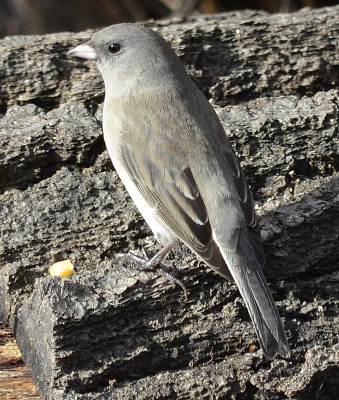When I was growing up, I enjoyed watching small grey birds with white tummies feeding on the seeds littering the snow beneath our bird feeder that had been kicked down by the doves. The grey sparrow-sized birds were called Slate Coloured Juncos, an appropriate name for the males with their dark backs, hoods and upper chests. Now these same birds are called Dark Eyed Juncos because science has caught out these birds in their little tricks of changing body colours across North America but actually being the same type. So now “Slate Coloured” is used as a descriptive term for the Dark Eyed Juncos common in southern Ontario and “Oregon” is the descriptive term for their western family branch. I’m always happy to see the first juncos when they arrive back for the winter even though I mostly see them flying hurriedly away flashing a white V of tail feathers back at me.
Why Do Juncos Have White Outer Tail Feathers?
I haven’t found a definitive answer for this question, but I have found some interesting facts.
According to AllAboutBirds, the Cornell University website, many birds flash white in their tails, and “possibly as a way of confusing predators.”
In a published paper titled “Diet quality affects an attractive white plumage pattern in dark-eyed juncos (Junco hyemalis)” by JW McGlothlin; D Duffy; J Henry-Freeman and E. Ketterson posted on the Indiana Univesity website, I also found out that “in male dark-eyed juncos the size of a white patch on the tail contributes to attractiveness and mating success.” The paper also states that in their testing, males fed a richer diet higher in protein were able to re-grow tail feathers with more white than those with a poor quality diet.
Perhaps this is a natural signal to interested females that a male is guarding a territory rich in food for their potential offspring or that he is a particularly adept forager. (This is my speculation; it’s not part of the paper.)
In other words, female juncos find males with wide white tail feathers more appealing than those without. I could see why this might result in a proliferation of juncos with white tail feathers!
I had not known, till reading the Indiana U paper, that male juncos have more tail white than females and older birds have more than younger birds. The paper also says that males do not find females with larger tail white any more attractive than other females. It’s a one-way street.
Which Junco Tail Feathers are White and How White Are They?
Here’s even more tail feather information from the Indiana U paper:
Apparently juncos usually have 12 tail feathers and if you count them from the center out, the white is usually on feather 4, 5 and 6 but is sometimes also on 3. The amount of white is the most variable on feathers 4 and 5.
I didn’t realize till looking at the photo included in this paper that the entire tail feather is not white. For example, for the fourth tail feather, the white begins 1/3 to ½ of the way down the feather from where it is attached to the bird. Even then, there is a dark edge to almost the entire feather.
Juncos Signal the Start of Winter
All this tail information may be a bit difficult to absorb but one fact is clear: When the Juncos arrive in southern Ontario winter will be starting soon. Their cheerful, if wary, visits help brighten a back yard left abandoned by the warm-weather warblers. For that reason they are very welcome indeed.
Related Reading
Join In
Have you ever noticed that the male juncos flash more white than the females? Or, like me, do you have trouble telling who’s who once they’re off and flying? Please share your experiences with a comment.





No – at first I thought it was a female Blue jay – but it’s not… they built a nest right in front of my front window in an orange-jasmine tree I keep trimmed …
Spring Juncos have arrived. One had a hard hit as it crashed into a window. It revived in the house but lost all tail feathers. Will they grow again? The little bird is outside now in pretty harsh weather. We drop seeds where it was last spotted.
Usually birds can recover from that type of feather loss. Hopefully it’s getting better already!
i have those bird on front of my house one nest and everything i go front door near spire bush the want to attack me .
maybe the have eggs now there goin to hard time bc i can even open my door to go out with umbrella to protect myself.
how long the have nest ? t
Sorry to hear you are under attack at your own home. If they are Juncoes, they usually nest for 22-26 days. I hope things improve soon.